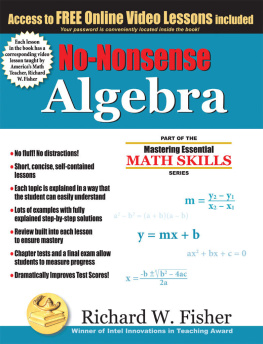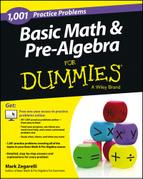Gregory P. Bullock, Ph.D.
Gregory P. Bullock, Ph.D. 2015
All Rights Reserved. This book may not be used or reproduced in part, in whole, or by any other means whatsoever without written permission.
Bullock, Gregory P.
This book is dedicated to making the United States of America number one in education in the world.
CODE [noun]: A system of pre-designated words, symbols, sounds, and arrangements with assigned meanings to communicate a message.
DECODE [verb]: To translate, unscramble, or extract meaning from a coded message to convert it into a form which may be better understood.
Word Problems are the Code .
You are the Decoder .
INTRODUCTION
Word problems may be one of the most feared and disliked parts of math. There is a major ongoing communication problem in the world of math education. The way that many textbooks and instructors teach doesnt connect with students, leaving too many confused, intimidated, and lost, which results in too many quitting and/or failing, who have the potential to do well. Not all students think and learn alike.
Many students have enough trouble with algebra. Many have more trouble with word problems because they involve new steps, such as setting up the equation, and other facets, such as using units. Yet, textbooks tuck word problems (or, applications, as theyre sometimes called) into a few pages at the end of a chapter. Students are expected to do them, and word problems often carry more weight per question on tests, yet the textbooks do not place enough emphasis on, or even really teach word problems. Many students and instructors are stuck in a quagmire of trying to learn it the textbook way, or even worse, trying to wing it.
This is why even more students dread word problems than plain algebra, and understandably so. Many students dont know where to turn for clarity. Meeting with a tutor often results in the tutor doing the word problems for their client. Still, not much is learned. When test time comes, too often I see students trying to figure out if they can still pass if they skip the word problems.
The major culprits are the textbooks, and sometimes the instructors who insist on doing it the textbook way, or just simply dont offer enough additional insight into how to do word problems. There is a major problem here. Either word problems are taught as being too much the same , with their differences not accentuated, or taught as each being different and random instead of drawing attention to the proper similarities .
This book addresses those problems head-on as it is dedicated to the mini-subject of word problems, as it should be treated, by teaching the basics behind them as a whole, but also identifying key elements and accentuating the differences of each specific type.
Another problem is that textbooks tend to focus more on the solving aspect but not enough on the most important aspect: Students usually dont have as much difficulty solving, but you cant get to the solving steps if you cant set up the equations. This book focuses on all aspects, with a special focus on the hardest part: The Setup .
This book introduces a new, simple, logical process for solving word problems from beginning to end, making sure to focus on the setup step. The secret behind the setup is to properly identify the type of problem (which I teach) and using what I call template equations associated with each type. In this book, students can search the word problem bank by type or category, and from there, either use the template equation, or setup the equation from scratch, as I also teach.
I wrote ALGEBRA IN WORDS: A Guide of Hints, Strategies and Simple Explanations (2014) to bridge the communication gap from the technical math language to students who learn better by worded explanations. With its success, I wrote ALGEBRA IN WORDS 2 (2015) which focused on more advanced topics using the in words explanations. Those books do not cover word problems because I wanted to focus specifically on helping students build a solid foundation in algebra. Then I wanted to take on word problems, focusing on them in a way that would allow students to learn them easier, faster, and more successfully. In the early stages of this book, I wanted to start from scratch and take a fresh look at them, trying to think like a new student learning word problems for the first time. I started testing my methods in my classroom to my students. Upon implementing my own methods and explanations, I saw students (who followed my methods) success on word problems reach near 100% (with the exception of occasional errors). Before then, I was used to having to deduct massive points on tests due to failed or not-even-attempted word problems.
Until now.
This book reveals the simplicity buried under the confusion and intimidation of word problems.
There are 50 word problems in this book, all representative of the types typically learned in an algebra class (see the full list in ). Each word problem is fully worked out and explained. Realistically, word problems need more attention than theyre typically given, meaning more, useful pages and explanations in textbooks, or, their own book.
Now there is one.
This book will teach you everything you need to know about word problems, from the background, to interpreting, to identifying, to setting up, to solving and answering the questions, and even how to properly do unit conversions. It will put you in total control, leave nothing to be desired.
This is WORD PROBLEMS DECODED !
HOW TO USE THIS BOOK: The 4 Phases
This book is divided into 6 main sections, each of which focuses on a specific aspect of word problems, but are also all connected to help you navigate to the areas where you need the most attention. You are not expected to read this book from cover to cover as soon and as fast as you can. This book is designed to be used as you go through your class, at your pace . To maximize the benefits of this book, follow these 4 phases, which will guide you through the appropriate sections and topics as you need them :
Phase 1: Reading the basics and general background of word problems
Read from this point up through the following sections as soon as possible (about 25 pages):
The next section is has hyperlinks to their corresponding Detailed Explanation sections for if or when you have questions about where the template equations come from .
Phase 2: Do the
This is a practice section that helps you work on and strengthen one of the most important steps in word problems: Identifying the problem . Equations can only be set up once you identify what youre working with. This phase and section will simply have you read random problems, identify key elements according to the . The hyperlinks will bring you to the answer.
Phase 3: Use Alongside Homework
This book is a great resource for using alongside homework. It is useful in a number of ways, whichever ways suit your needs best. It really just comes down to following the under Annotated Examples, which are hyperlinked (but grouped differently, not in the chronological order as you will cover them in class). Clicking either hyperlink will take you to a fully annotated example, which will guide you through all aspects of an example problem.
You might choose to look at the Unknowns to help you set up your unknowns. You might choose to go right to the template equation and plug-in the given numbers from your homework problem, then solve. The annotated examples in this book will likely use the same type of equation and type of math involved in solving. For more background on each problem, follow the hyperlink for detailed explanations on that particular type of problem.









